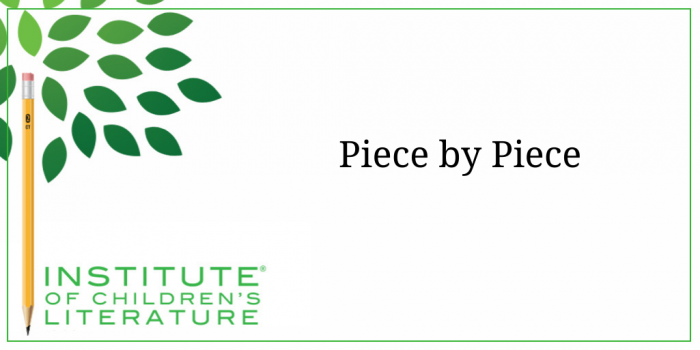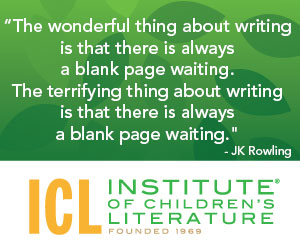1000 N. West Street #1200, Wilmington, DE 19801
© 2024 Direct Learning Systems, Inc. All rights reserved.

We teach our students how to write and get published!
View our Course Catalog >

Premise is Your Idea
If you’re a genre writer (like I am), many times the premise is the first thing you come up with in a story, but that can happen even with literary writers. A premise can be an idea or it can be a question. For example, I was once chatting with writers about exposition and I came up with a spur of the moment bit of exposition that used humor to pull the writer through the dullness of being “informed” (which is what exposition is, information the writer feeds the reader). But this still bit of exposition stayed with me. I pondered it. I poked at it. I contemplated what kind of story could contain this exposition. And eventually I turned it into a chapter book that was published as part of a literacy program. But the end result grew out of a seed in that silly exposition. The seed was basically that a space colony really only works if everyone in it works in unity, but what happens when one of your colonists simply cannot help but be an agent of chaos, a monkey wrench in every bit of works? From that premise, a story grew as I developed it as I found the other parts the story needed to work.
An idea or premise isn’t a plot so you’ll probably benefit from more development before you launch into the story writing, but it is an important piece in the process. When I was asking myself questions about this agent of chaos (questions about his age, his motivation, the people around him, the ways in which he injected chaos into the colony, the effects of his behavior), I was filling in the other parts of the story development matrix. I was preparing to write.
Stories Need Characters
A story that has no characters would certainly tend to be dull. You need to populate your premise and plot with the people needed to get things moving. But there is something important to remember: characters aren’t tools or props, they’re people. And people are complicated. People do wonderful, noble things. And people do silly, unfortunate things. And people do things that have horrific consequences to themselves and others. People often play a part in their own misfortune, but they rarely bare all the blame, because people and life are complicated. So if you populate your story with people who don’t matter to you, who don’t feel real in your head, who don’t have needs and desires and strengths and weaknesses, then your story is almost certainly going to be a struggle to write from beginning to end, and isn’t likely to feel satisfying for the reader.
As we imagine our characters complexly, we run the risk that these characters may give us some trouble later in the story. You’ll hear writers say things like, “I planned to have my main character marry him, but she just refused.” Or “I was going to make my main character an only child but this sister just insisted on popping into his life.” This is just the author’s way of saying, “As I thought of my characters more complexly, I had to write something consistent with the characters and world I had created. Now, this second statement is more accurate, but certainly sounds less whimsical and romantic than imaginative anecdotes about how your characters take over and write themselves. They don’t. You still have to write them. But if you imagine them into a kind of reality, then you’ll find yourself sometimes feeling a bit like you’re along for the ride as you drive all these characters you’ve created through the plot. As you write, you’re constantly adjusting what you imagined in your preparation steps. You need to make every piece fit together in a way that feels honest and right.
Change, the Universal Constant
Many times when people talk about plot and story development, they’ll talk about conflict. And conflict is important, but there is another way to look at the story, and that’s looking at it via change. You’ve come up with this story idea (premise) and you’ve imagined your complex main character, now you need to think about ways this character and their circumstances could change that would be satisfying to the reader. Because change is the core of what you need to develop from premise to plot.
Let’s think about another story I once wrote and sold. In it, I had two sisters who have a rowdy argument (as sisters do). They are two very different people. One is the eldest and sees herself as rightfully endowed with certain traits, responsibilities, and entitlements. Surely, her extra years on the earth have made her wiser and her little sister ought to listen to her. She’s sometimes put in charge of the younger sister so the younger girl should be used to doing what she says. So why is she always resisting? As I think of this character, I draw on my own life and times I was frustrated in dealing with my younger brother. As a result, it was easy for me to relate to the character and to imagine how she would act in the circumstances she encountered in the story.
But then I needed to think more deeply of the other character, too. If you only consider one character in a complex way, it would be easy to slap a stereotype on the second character: “whiny” or “spoiled” and just try to write the story only really knowing one kid. But that wouldn’t lead to the best story possible, because it wouldn’t feel real, with real people. And all the “younger siblings” reading the story would tend to find the over simplified character insulting. So I needed to understand that younger character complexly also.
So I thought about the younger sister. She does get stuck with her older sister as babysitter a lot, too much in fact. And it’s slopping over onto every interaction between them. They can’t play a board game even without her listening to lectures about stuff she already knows, like the rules. Doesn’t her sister know she isn’t her boss? Why doesn’t her big sister want to be her friend instead of her mom? As I imagined this character in more complicated ways, I drew on my feelings when dealing with my bossy older brother (sometimes being the real-life middle child is a writer bonus). Once I made each girl real for myself, I knew neither one of them was being horrible just to be horrible. They were both acting out of the complex feelings they had about the situation. But as I imagined them more deeply, I found the plot solution because I saw one more thing: despite the conflict, they loved one another and didn’t really want to stay mad. I realized that both characters wanted the situation to change, they just didn’t want to do it in a way that made them “lose.” Once I knew that, I could find the end of the story that felt real––that is, not too easy or “nicey-nicey.” I could find the change that would bring about the story’s end. So I did, and I sold the story to Pockets magazine.
The longer your story, the more changes are likely to happen and the more characters they will happen to. In a magazine short story, you’re probably only going to see one main change, and it may really only affect one person. But in a novel, you’ll find many changes: changes of circumstance, changes of character, changes for the main character, changes for side characters. And if you’ve imagined the characters through a detailed eye, these changes (plot and subplot) will grow very naturally out of the people you’ve created and the things that make these people tick.
Where Are You Going To Do This?
Premise often determines setting. The story of the boy who brings chaos to the space colony really worked best in a space colony. But a story of a boy who tends to rebel against too strict suppression of his creative, active nature could possibly happen in lots of places. I could take that boy and drop him into a summer camp that’s a little too rule happy, and he would soon bring on the chaos. I could take that boy and drop him into his older sister’s wedding, and chaos would ensue. So most characters still act like themselves even in totally different settings. In fact, it’s an interesting creative exercise to take a main character you’ve created (and like) and try dropping him into different situations that would tend to put pressure on the child’s nature. For instance, if you’ve created a very organized, focused child, being in a very rigidly controlled situation wouldn’t really offer as much potential for interesting plot. So where would you need to place the child in order to create “a fish out of water?” Perhaps a more chaotic, creative situation like a summer camp for theater kids? Then the pressure of chaos on an orderly child would encourage change.
Setting and situation need to “rub against” the rough edges of your character. A setting where your character is perfectly comfortable and perfectly content isn’t likely to produce a perfect story unless you open in that place and then immediately throw in a nice tiger to tear things up. Like the story of the child who loves his quiet, rather isolated rural life until his city cousin comes to spend the summer and ruin everything!
Never Forget Your Ticking Clock
A last thing to think about in a story is how long it will last. Time can be used to intensify discomfort for your main character: “three whole weeks at this crummy summer camp” or “only twenty minutes to clean up this mess before mom gets home.” Time can also be used to thrust your story into a situation where your premise is capable of happening. Perhaps your novel needs to be set a bit into the future when humans do most of their socializing through machines or thrust well into the past when the act of surviving took up most of your day. Time in a story, like pretty much everything else, shouldn’t just happen. It needs to be carefully chosen to facilitate your goal for the story. Short time can build tension. Long time can overwhelm with its very weight. Also, know that a very short amount of time can also be used to help corral a plot so that you can accomplish a short story within the word counts. The short story described above about the sister’s fighting, for example, took place in about the space of an hour of their time, and that made it much easier to accomplish a full plot in a short word count.
Ultimately, the first step in any story development is imagining, thinking, pondering, and musing. After all, you’re a writer. Daydreaming is called “work” for us. Isn’t that just grand?
With over 100 books in publication, Jan Fields writes both chapter books for children and mystery novels for adults. She’s also known for a variety of experiences teaching writing, from one session SCBWI events to lengthier Highlights Foundation workshops to these blog posts for the Institute of Children’s Literature. As a former ICL instructor, Jan enjoys equipping writers for success in whatever way she can.
1000 N. West Street #1200, Wilmington, DE 19801
© 2024 Direct Learning Systems, Inc. All rights reserved.
1000 N. West Street #1200, Wilmington, DE 19801
© 2024 Direct Learning Systems, Inc. All rights reserved.
1000 N. West Street #1200, Wilmington, DE 19801
© 2024 Direct Learning Systems, Inc. All rights reserved.